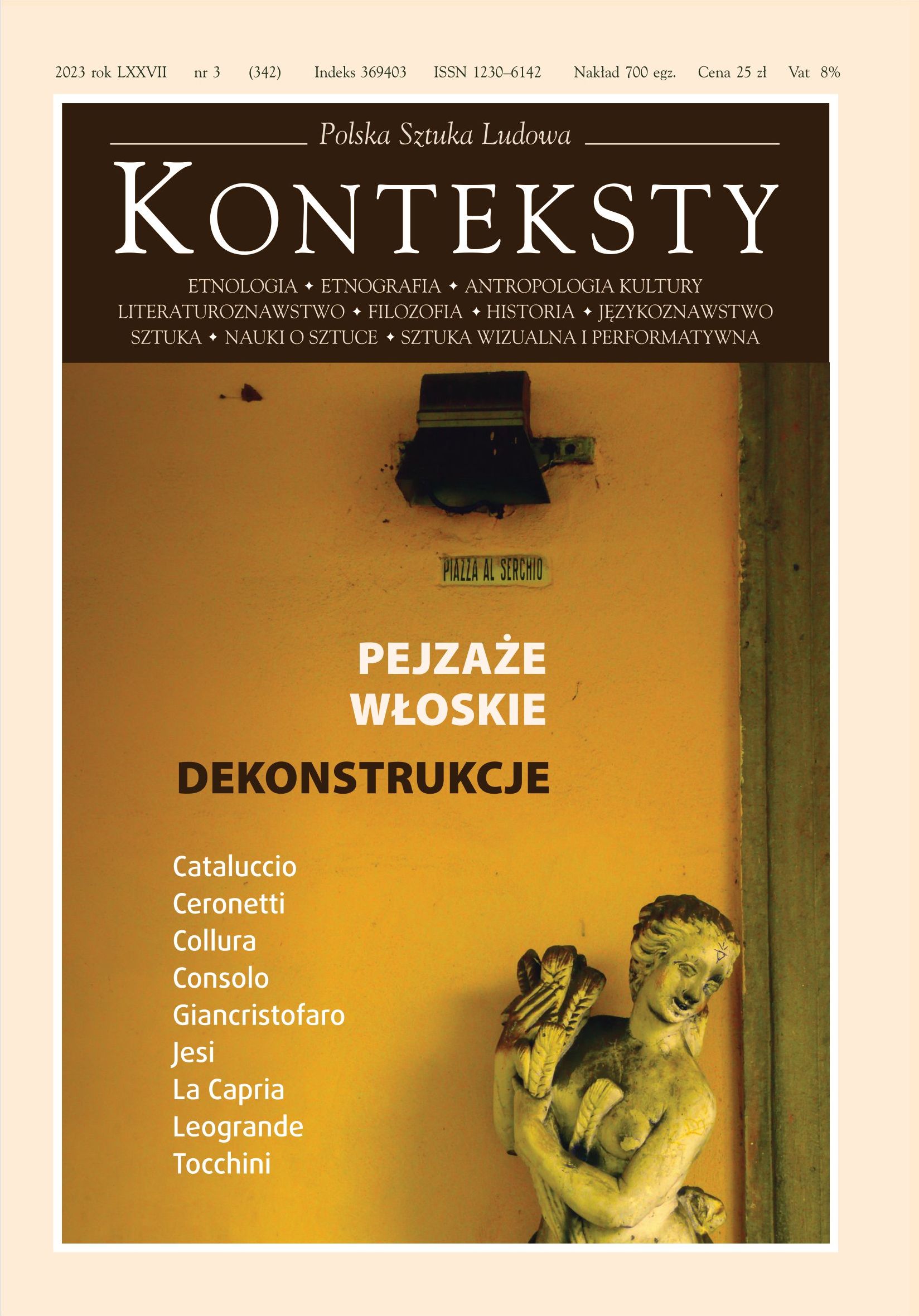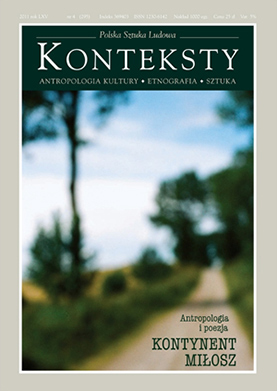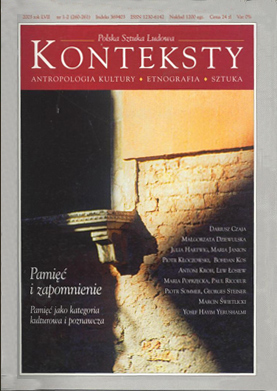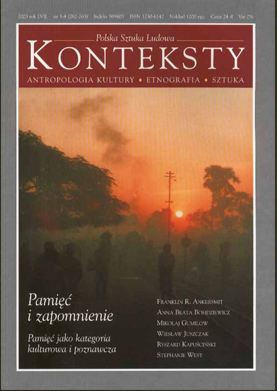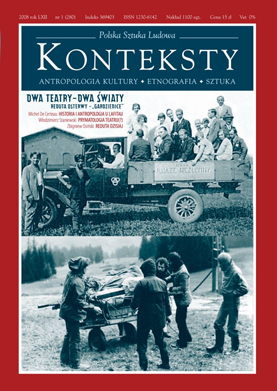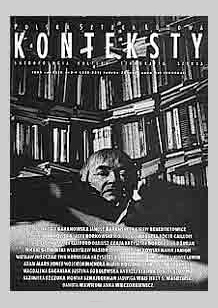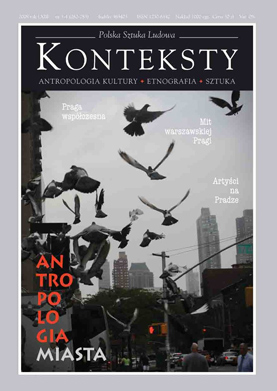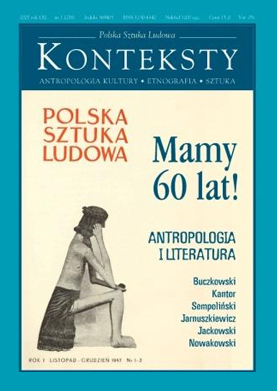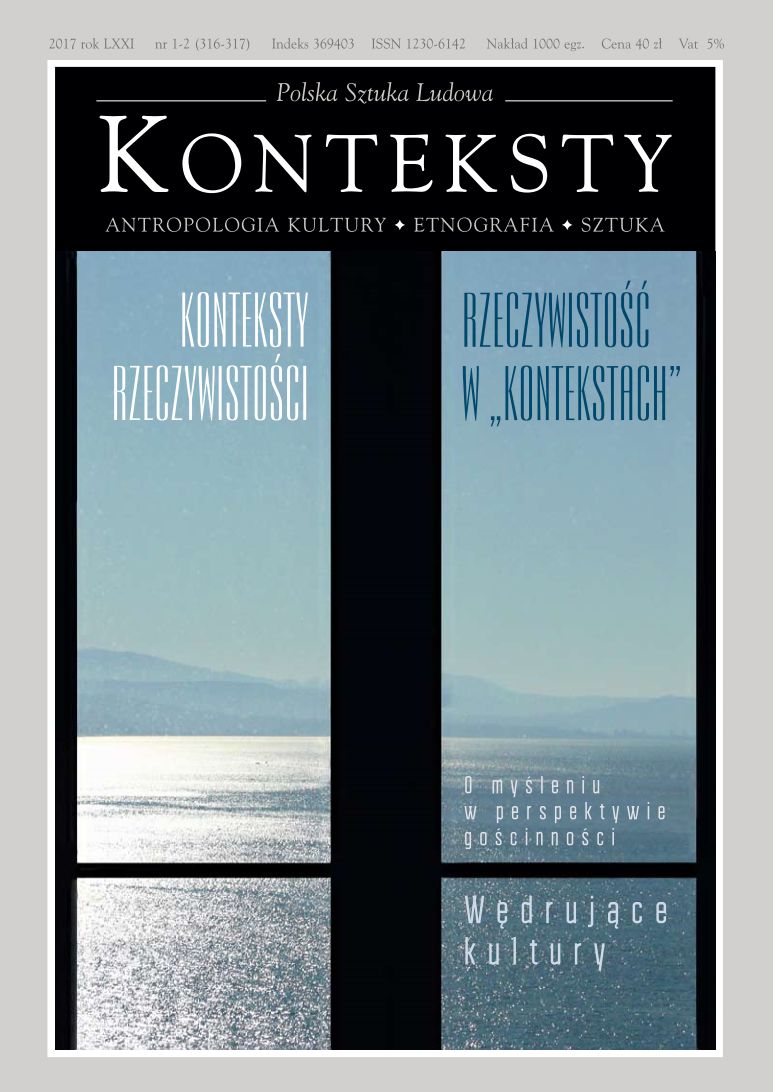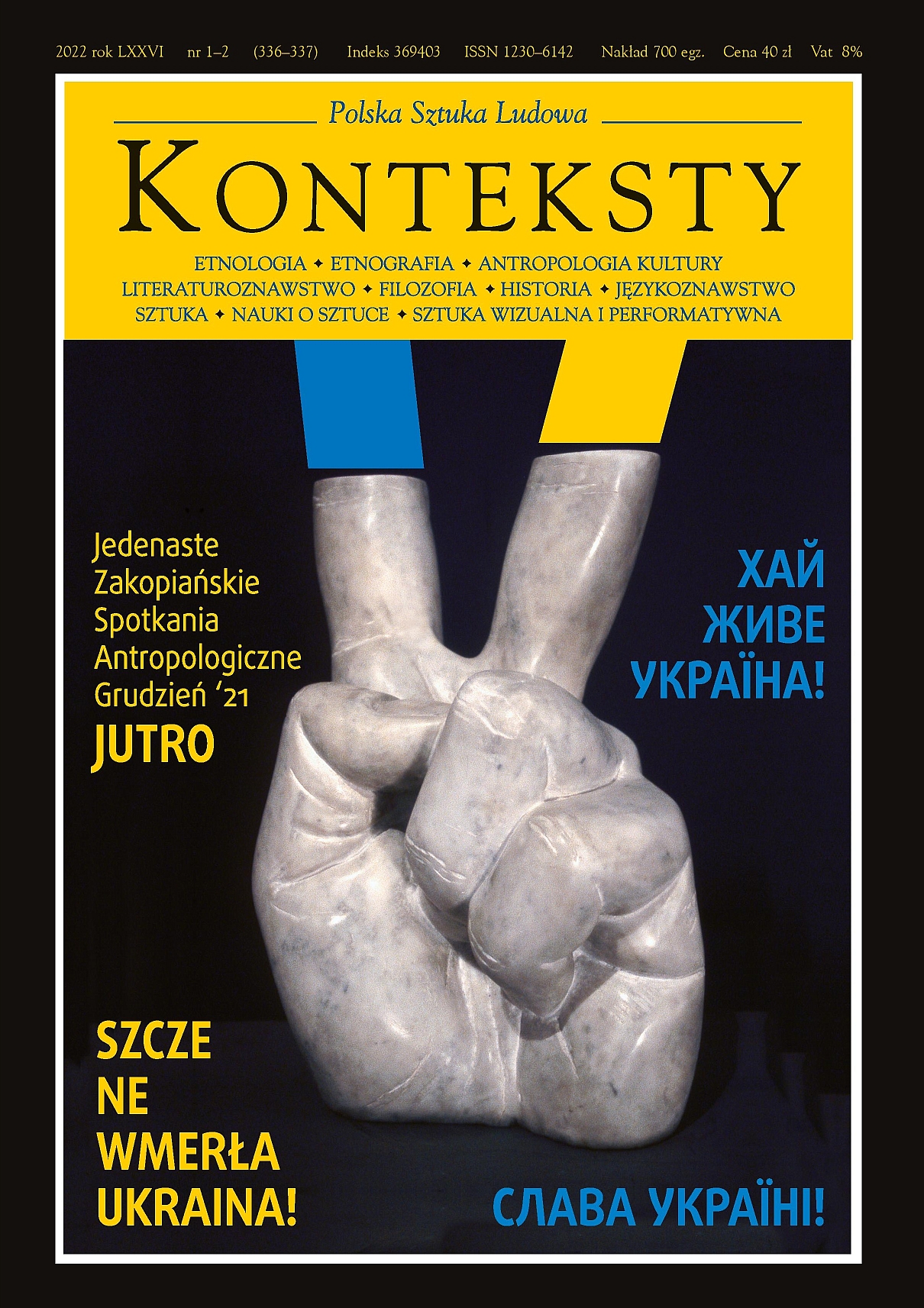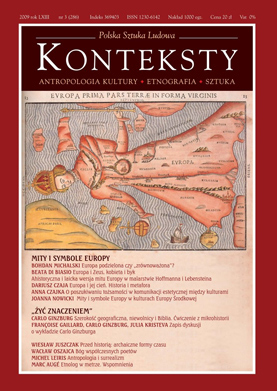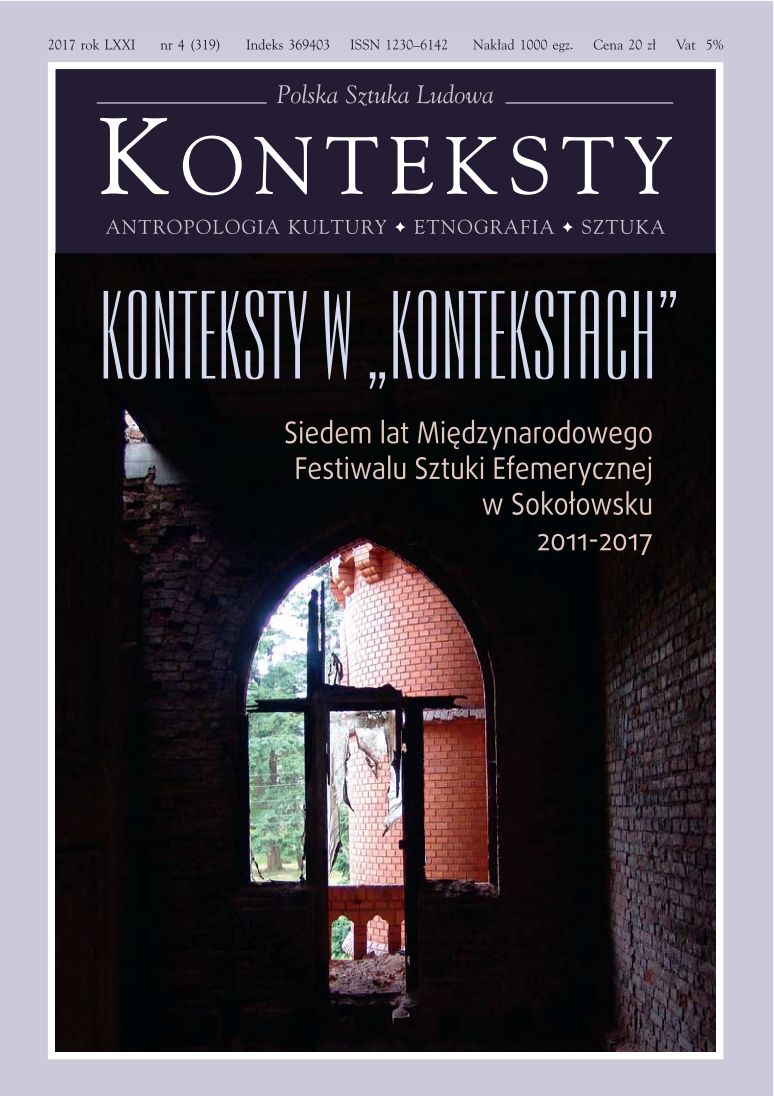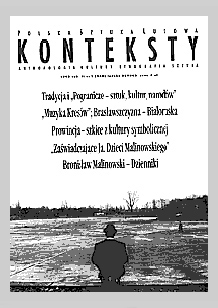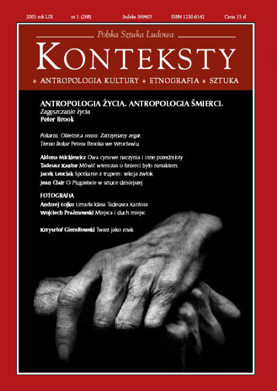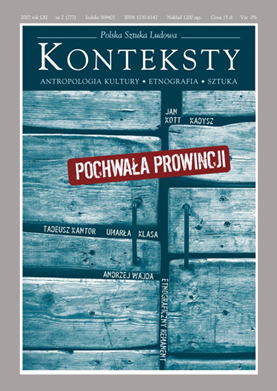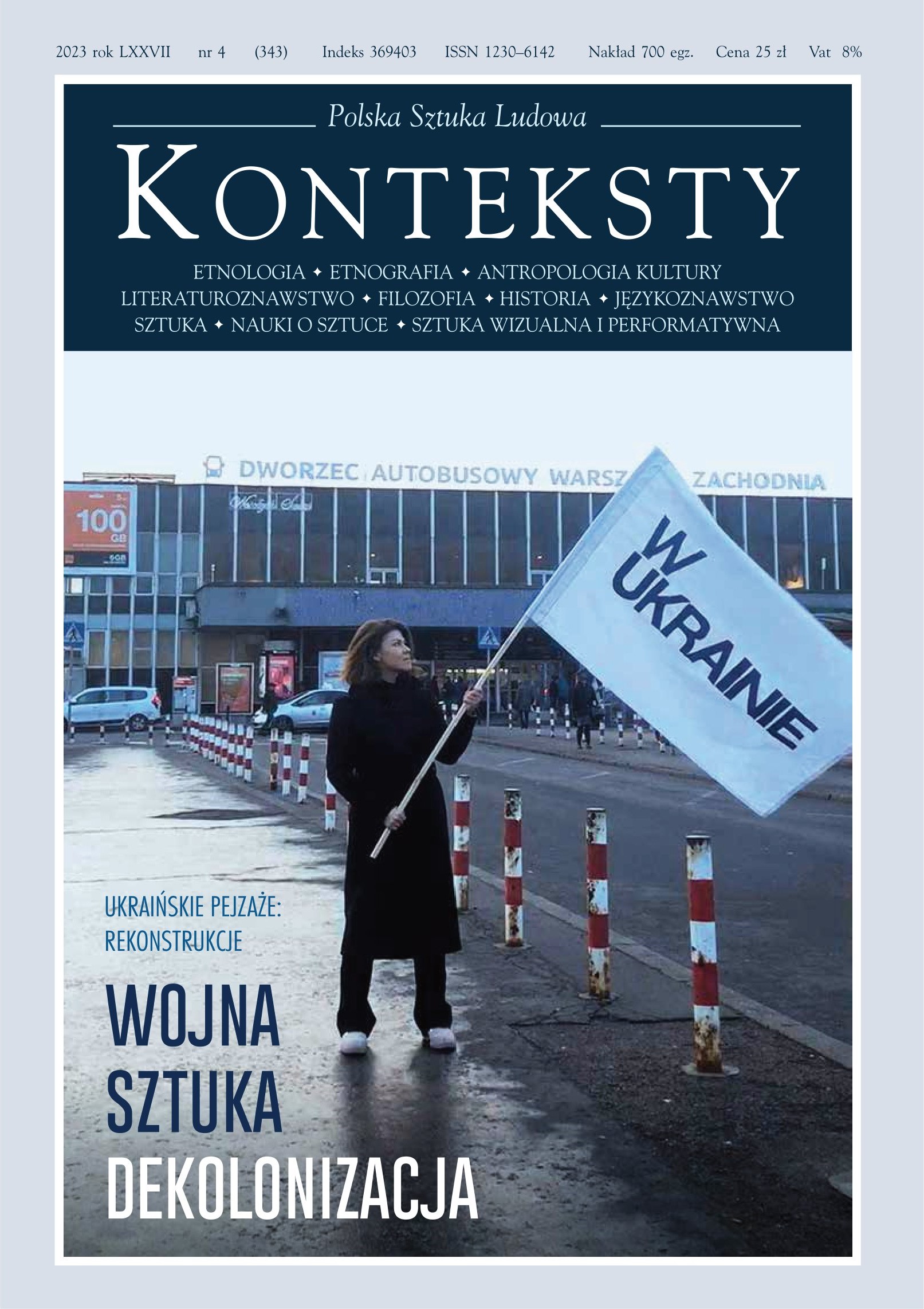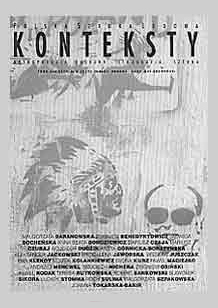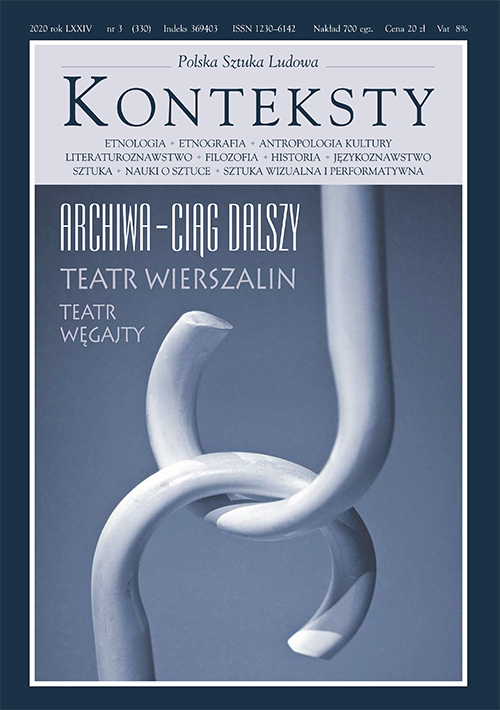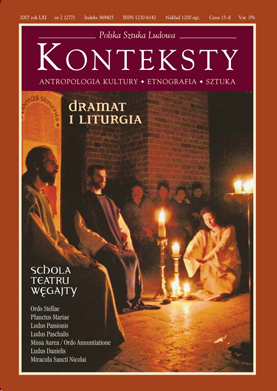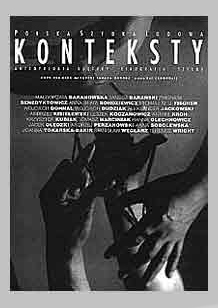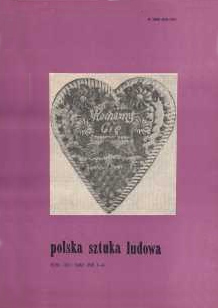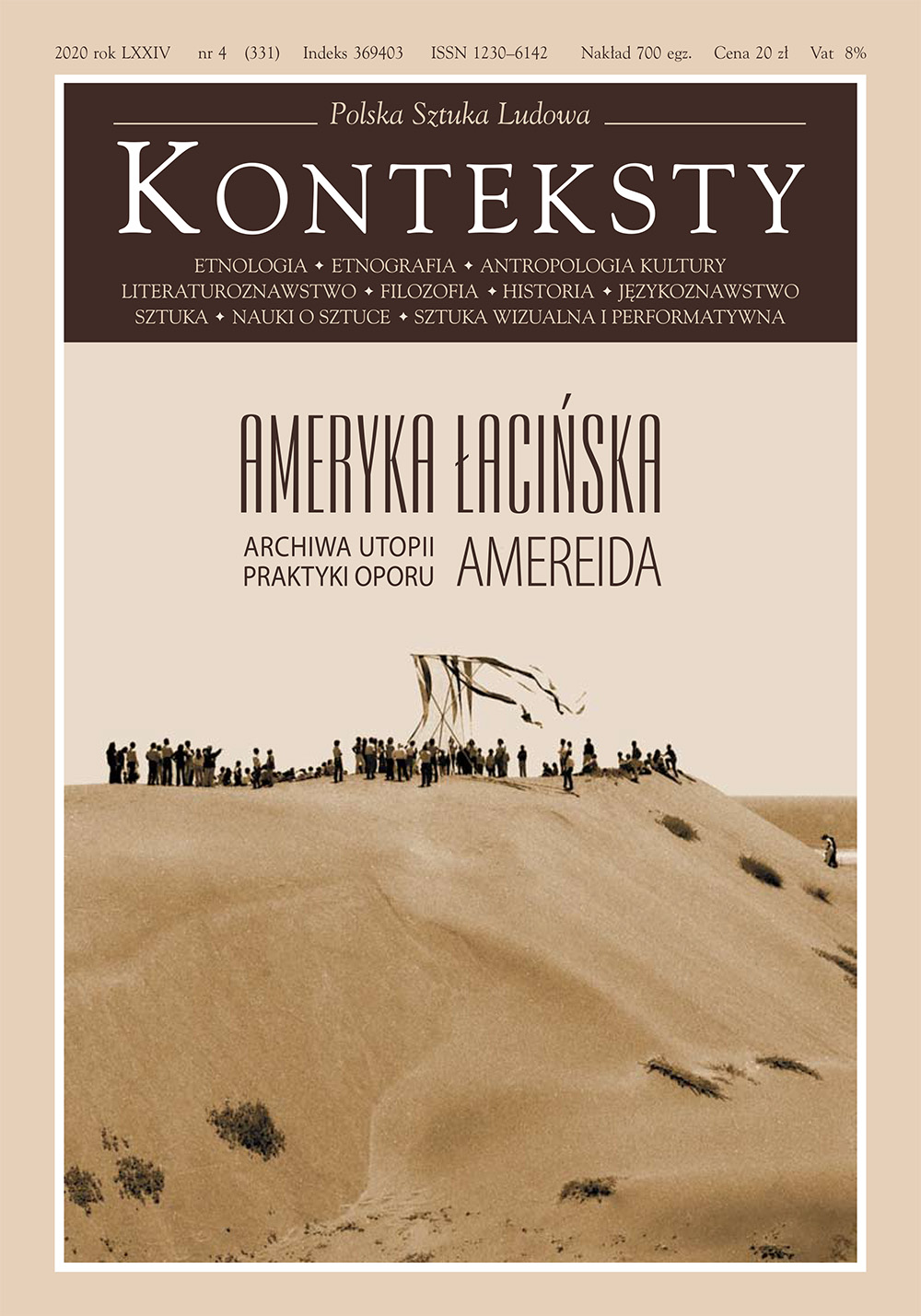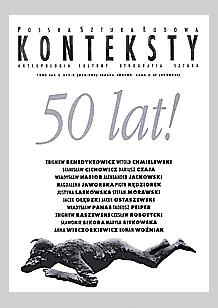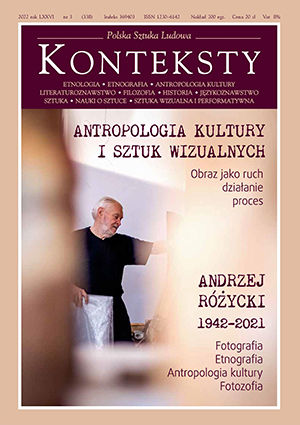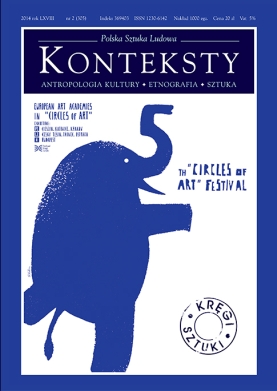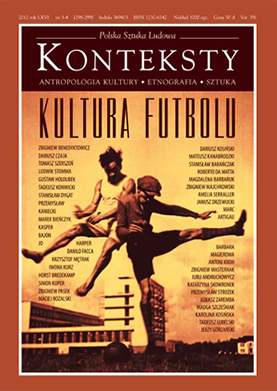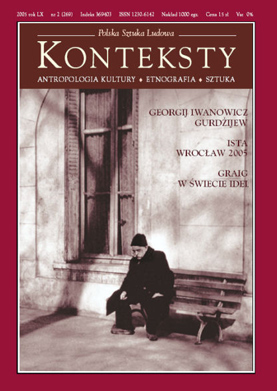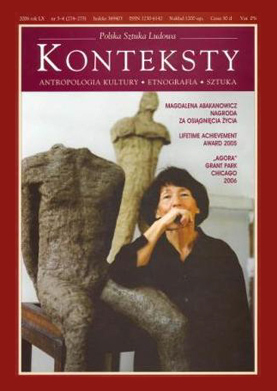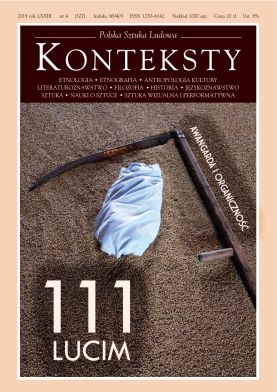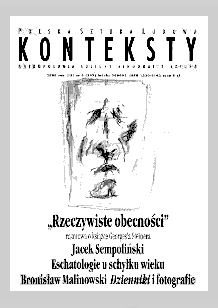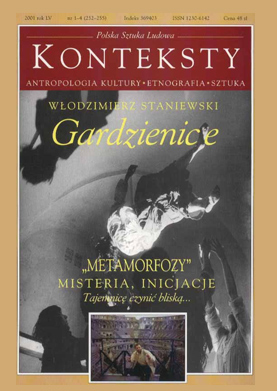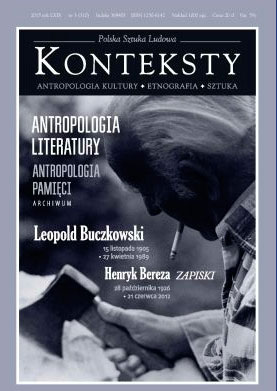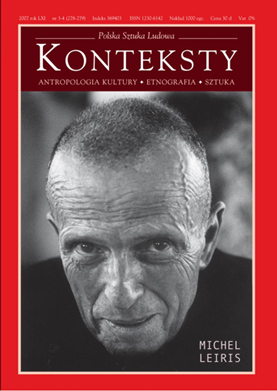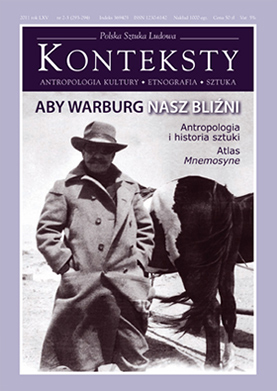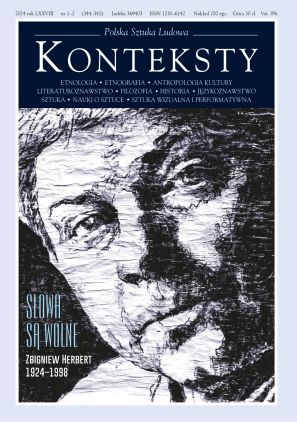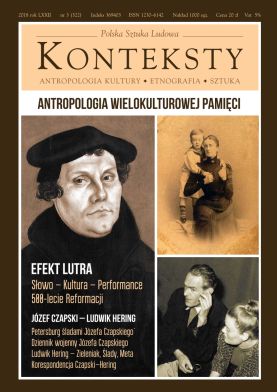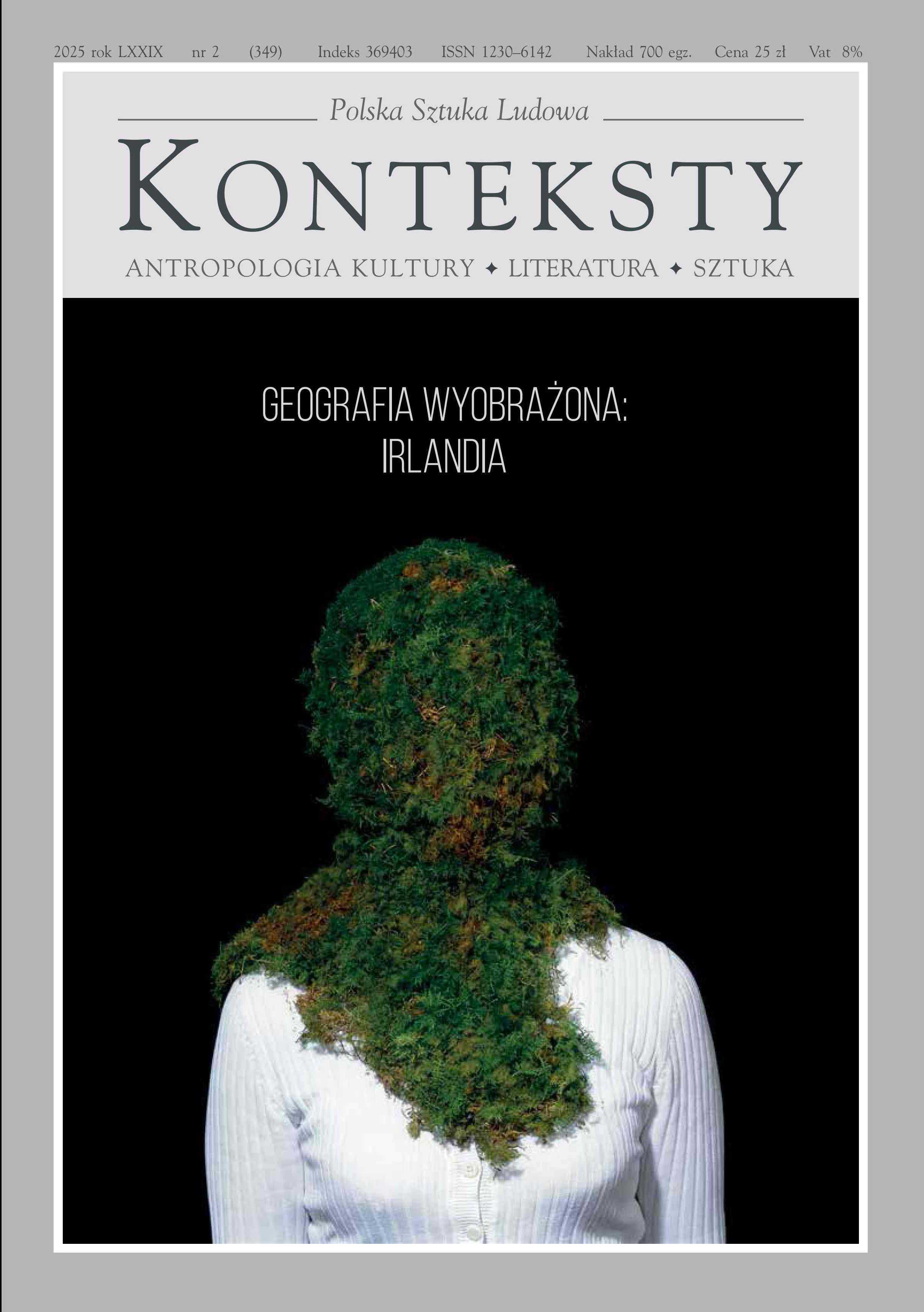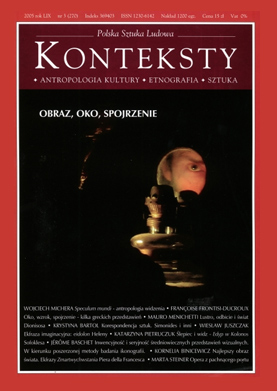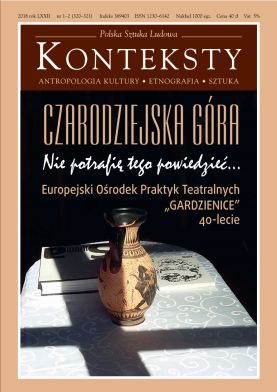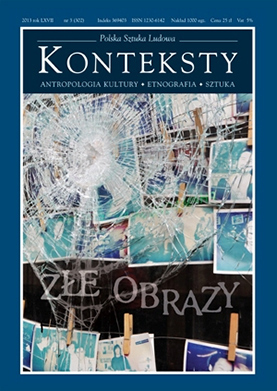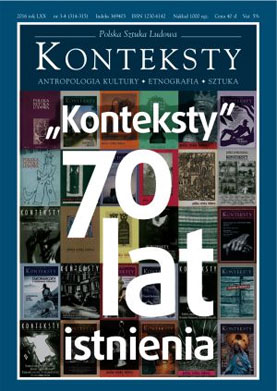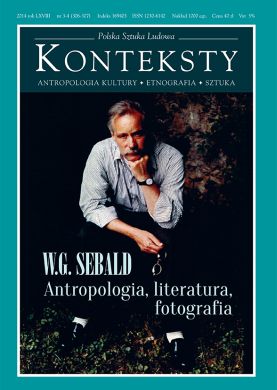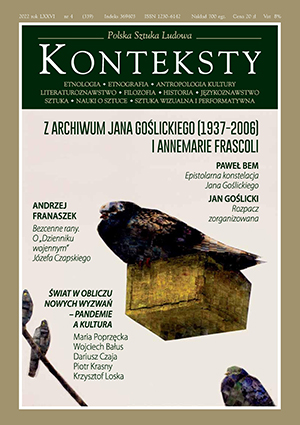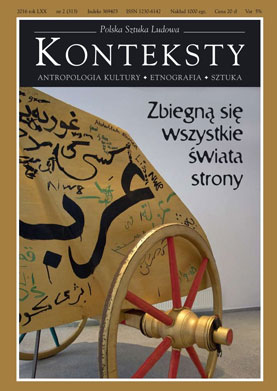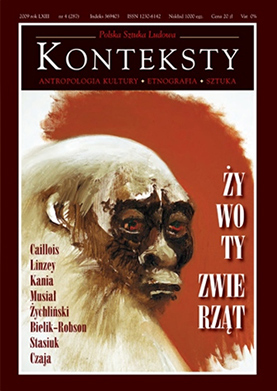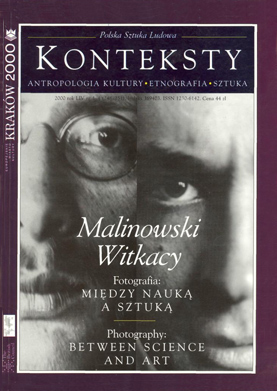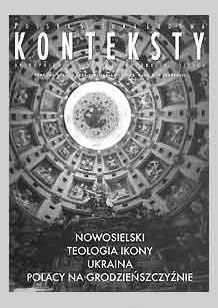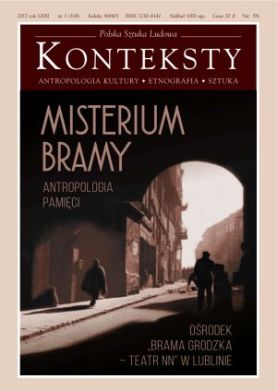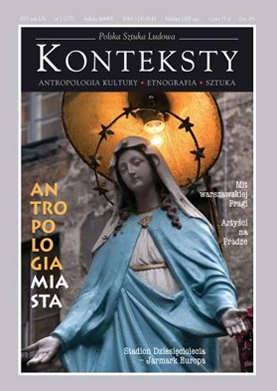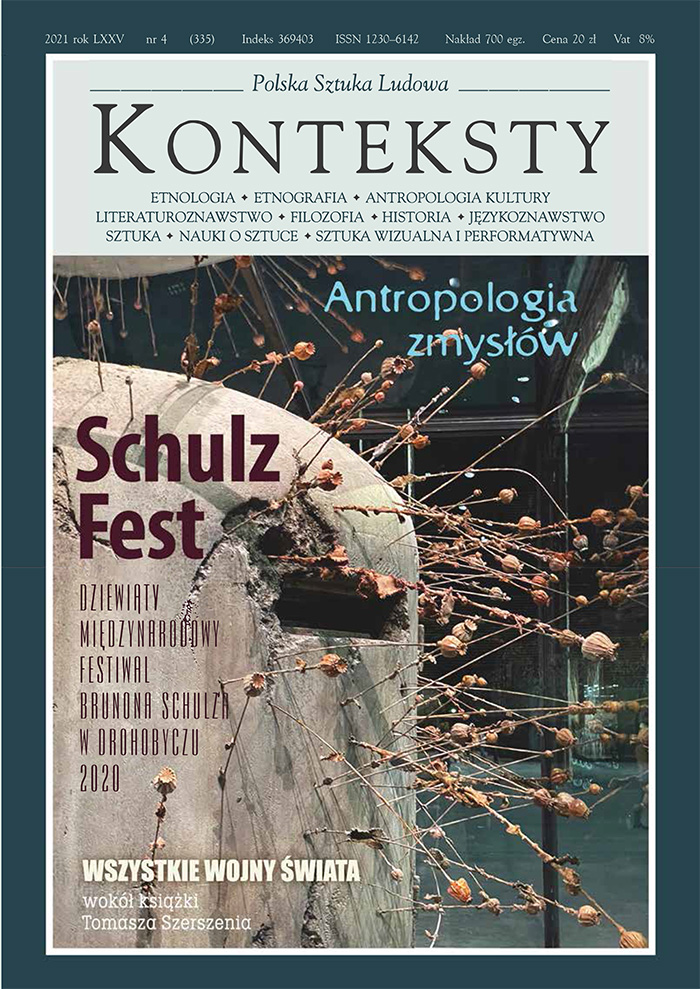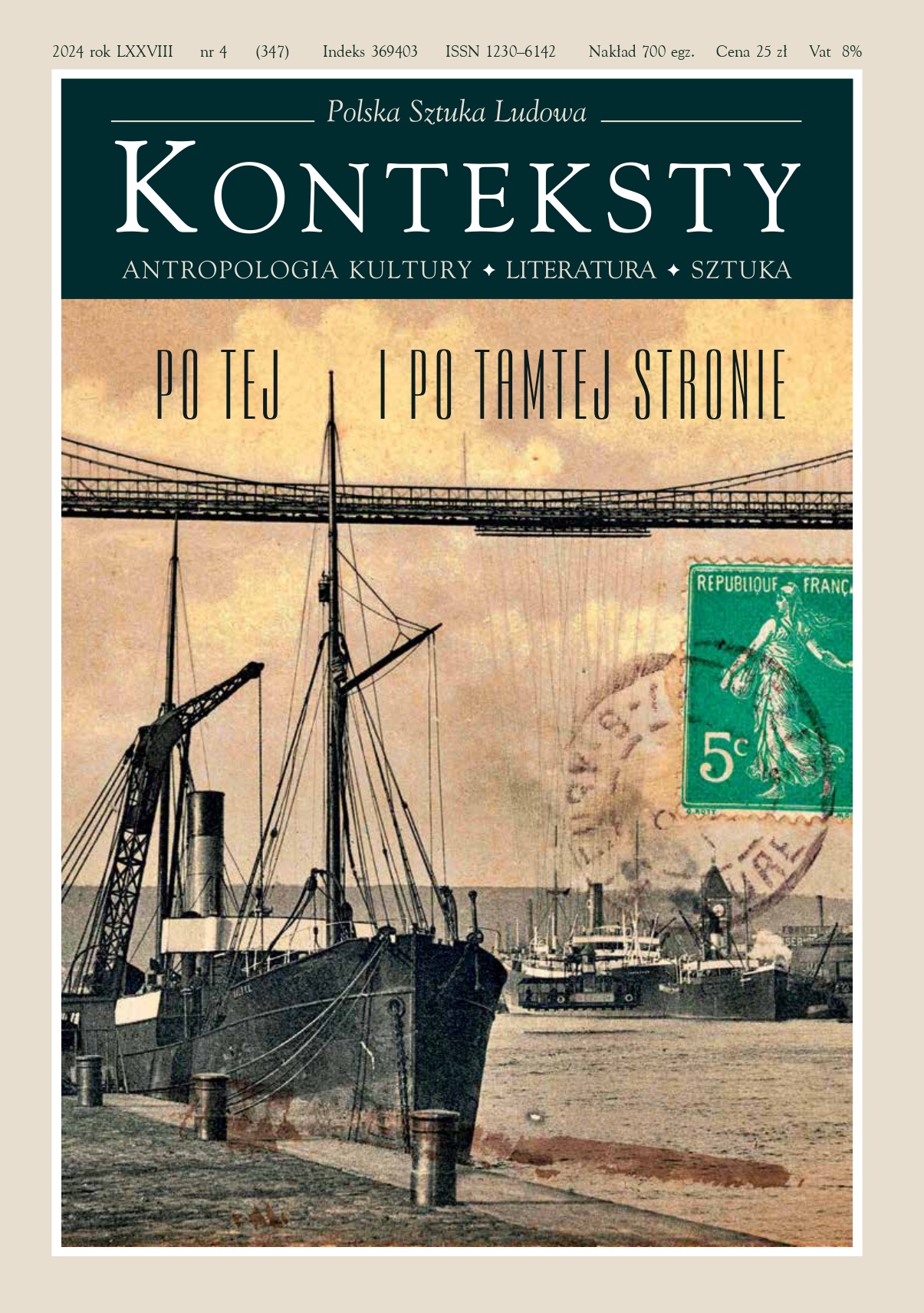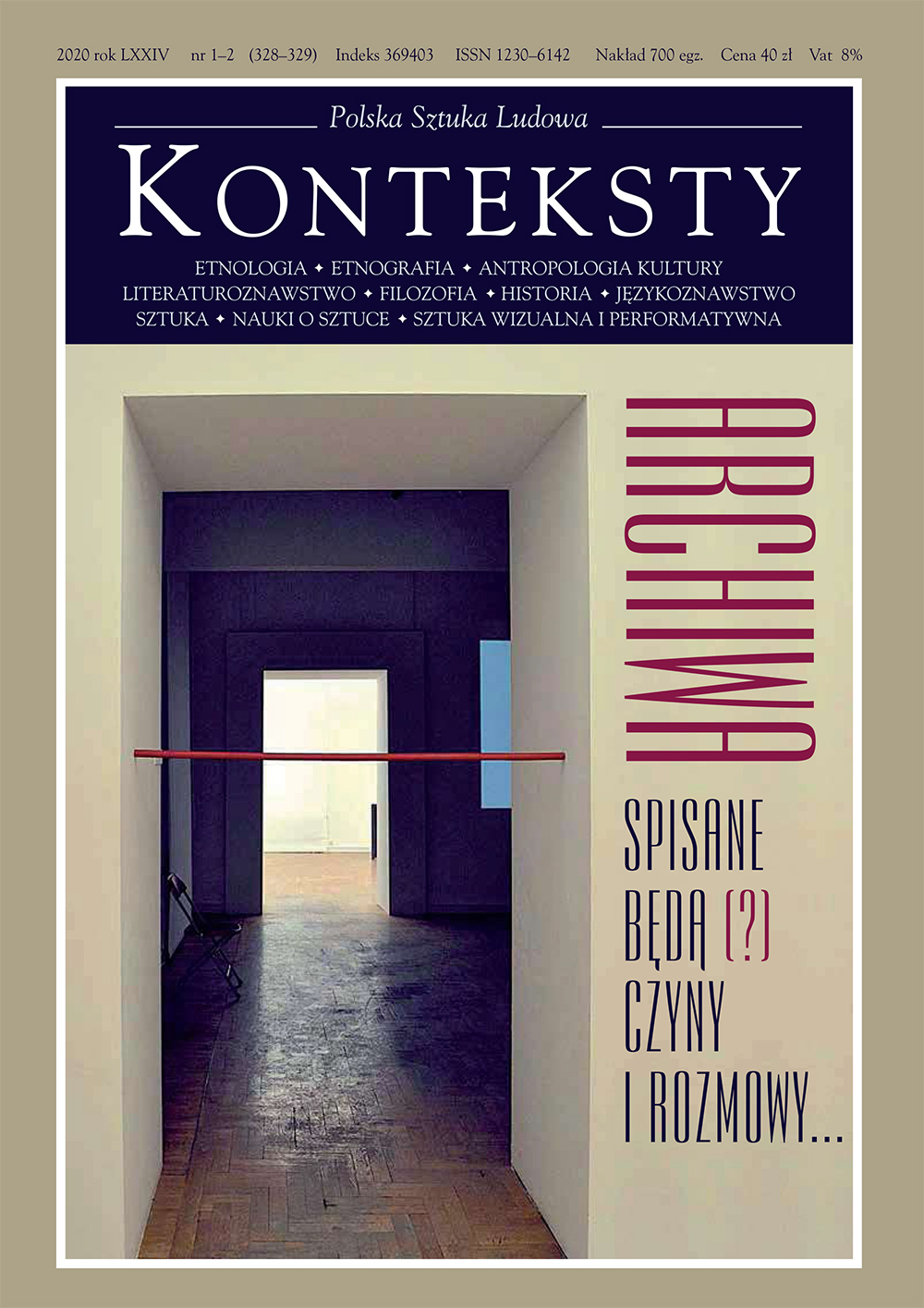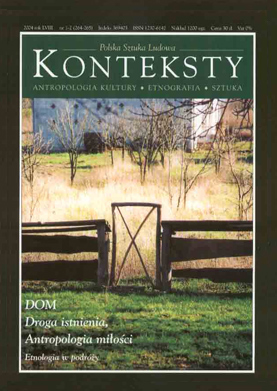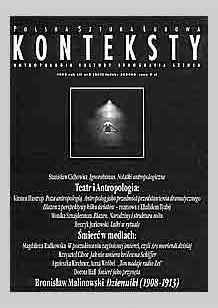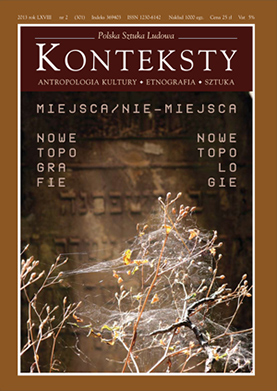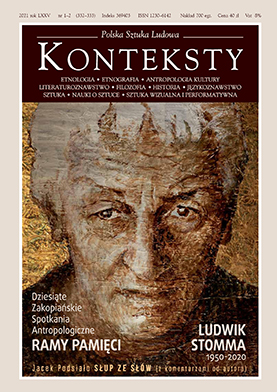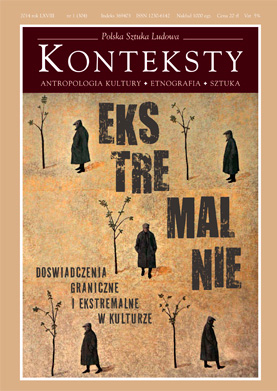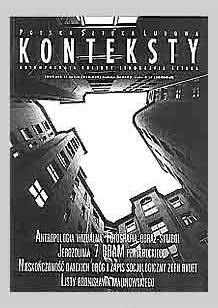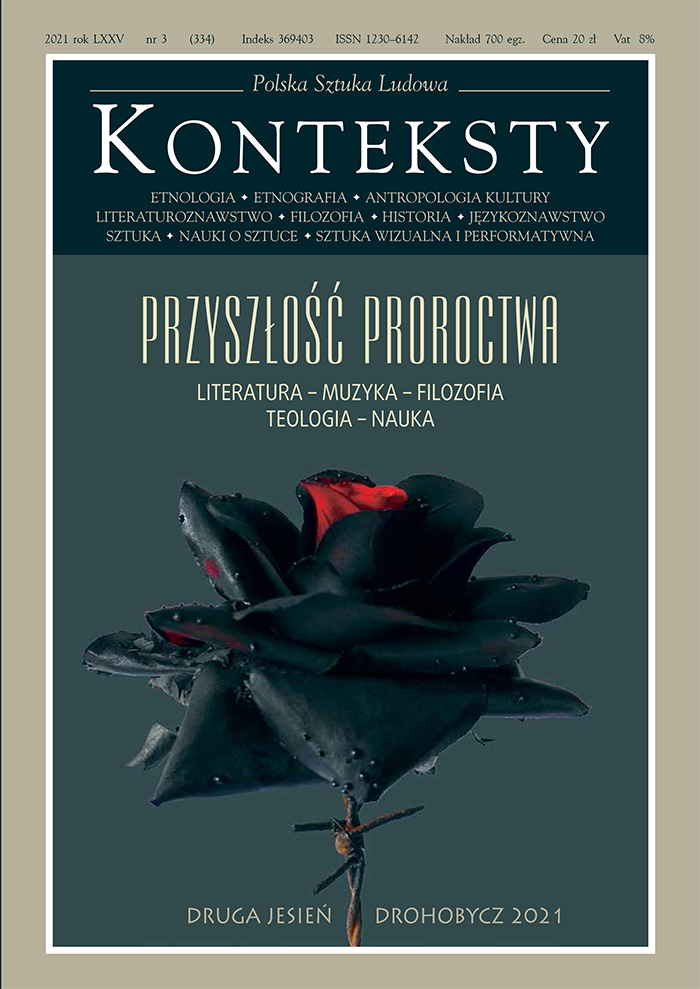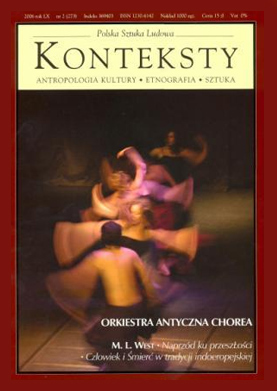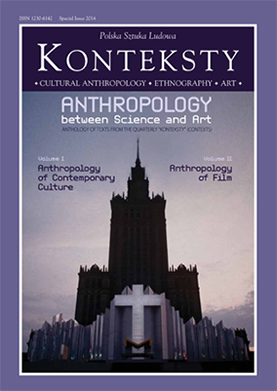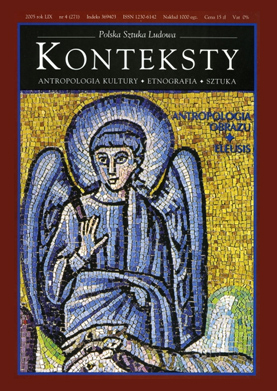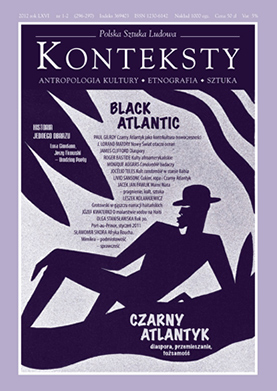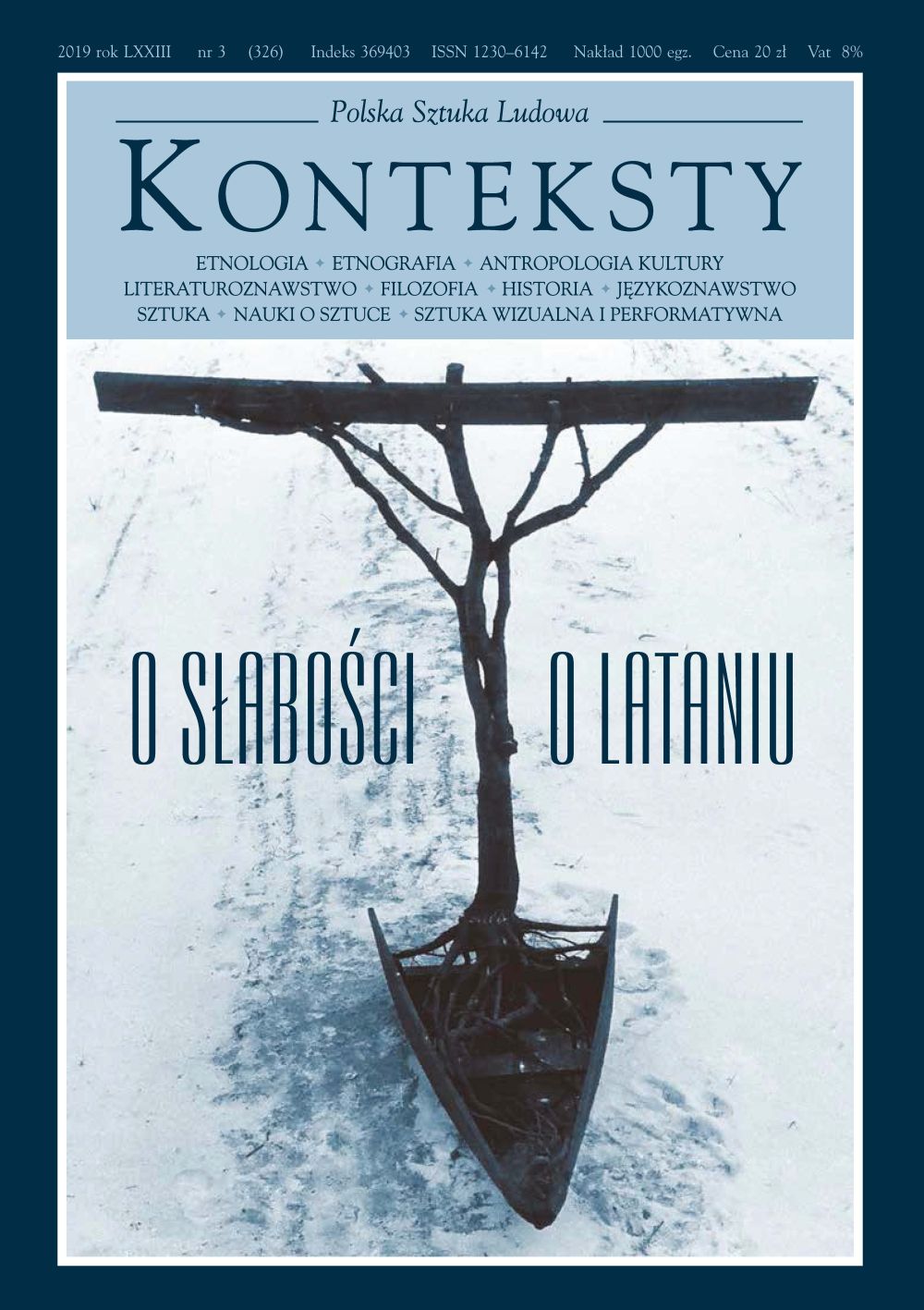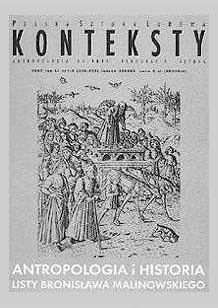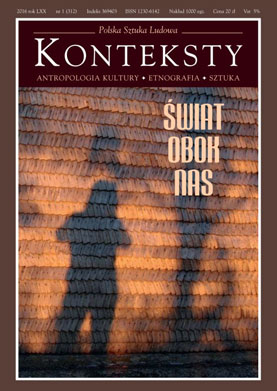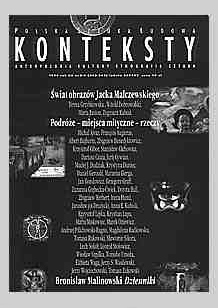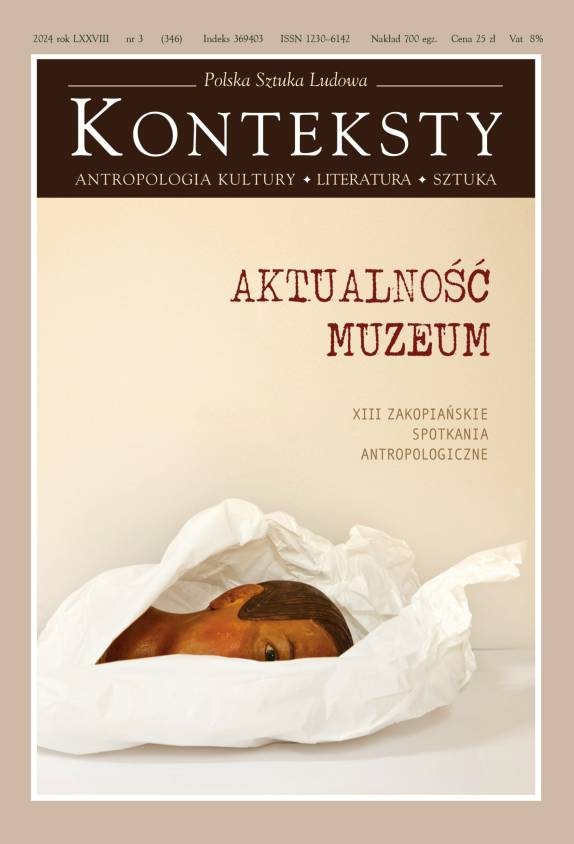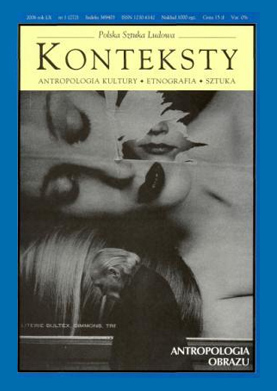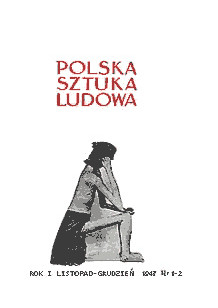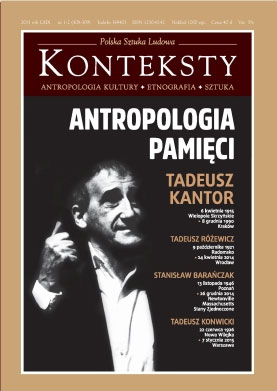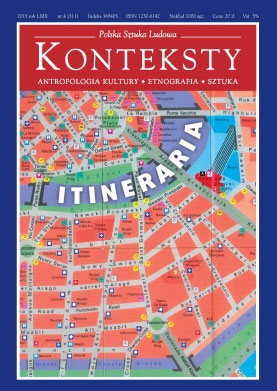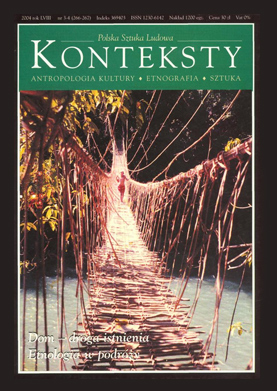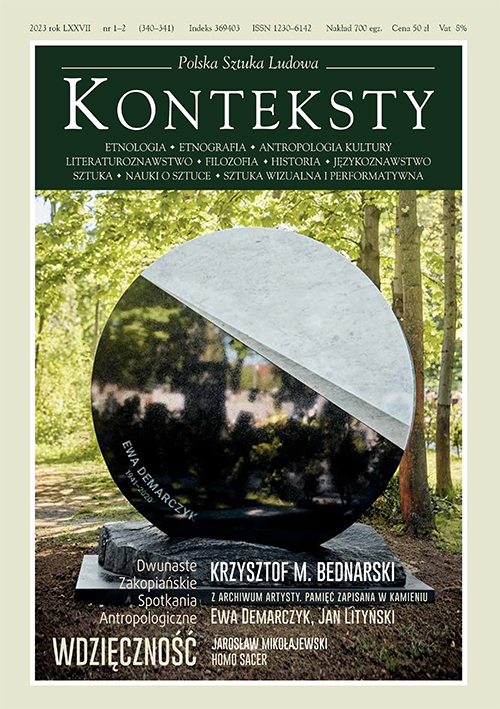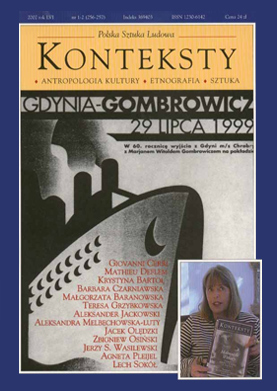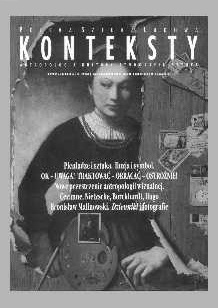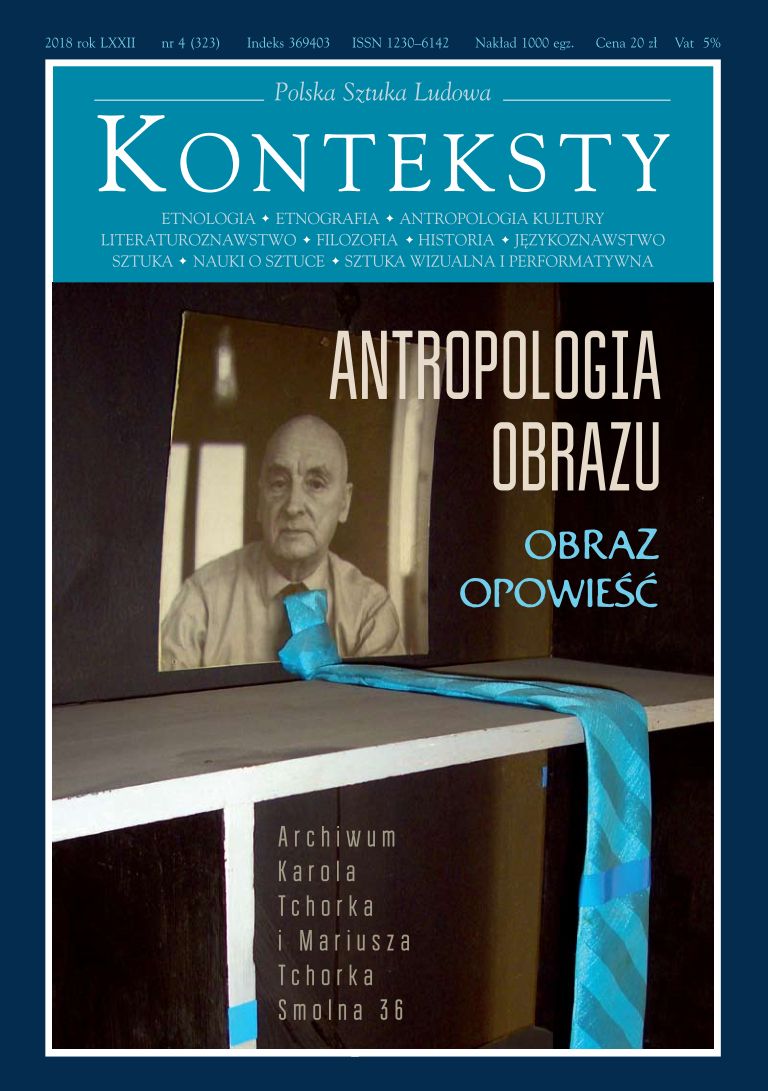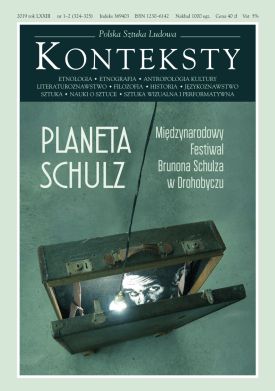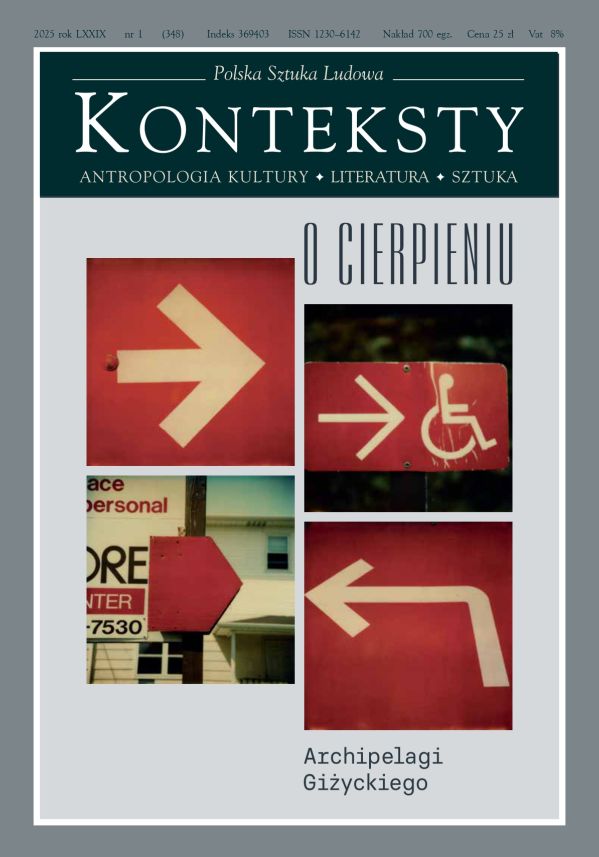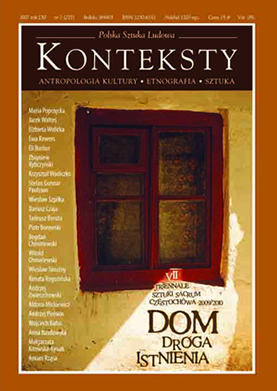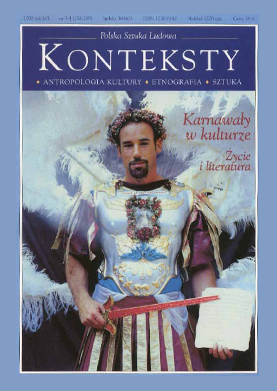Issue 2023/3 (342) - Italian Landscapes. A Deconstruction
| Italian Landscapes. Deconstructions | ||
| Dariusz Czaja | Do You Know the Land Where the Lemons Blossom? Assembling Italy Anew  | 5 |
An introduction to the contents of the issue. In the proposed volume we would like to view Italy from an anthropological distance and observe Italian specificity from afar (by creatively activating Levi-Strauss’ le regard éloigné); this appears to be a cognitively successful strategy. The title: Italian Landscapes is rather capacious and refers to assorted spheres of reality. The term “landscape” has been accepted in full, together with its ambiguity and vagueness. To put it in simplest possible terms: we wish to once again take a close look at assorted Italian spaces, both those with a dominant of elements of Nature as well as urban landscapes. | ||
| Prior to the Journey | ||
| Dariusz Czaja, Magdalena Barbaruk | Italian Journey, Today on Reading and Writing about Italy  | 7 |
This conversation is about a literary genre known as “Italian journey”. The prime issue caused today by this type of literature can be summed in a single question: what does a journey to Italy signify? Can it be actually still possible? In other words: can one really travel to Italy? “Really” means in the manner in which a journey of this kind was undertaken by such great precursors of the genre as Goethe, Gregorovius, Stendhal, and Muratov. This question leads to a serious cognitive issue: are contemporary texts dealing with Italian reality necessarily forced to shine only with light reflected from canonical texts of the past? Are we doomed to repeat solely narratives of old and to succumb to cognitive clichés, or are we capable of seeing something else than what was perceived by our great predecessors and leave behind an image of Italy matching great travel literature? | ||
| Old Topographies, New Contexts | ||
| Guido Ceronetti | My Voyage to Italy Florence, Pistoia, Lucca  | 17 |
A translation of fragments from Guido Ceronetti’s collection: Un viaggio in Italia 1981–1983 (1983 [2014]), dedicated to friends of invisible Italy (“Agli amici dell’Italia invisibile”). On his Italian voyages Ceronetti follows quests for non-standard sites by evading accepted schemes. In the translated parts of the collection peregrination destinations include Florence, Pistoia, and Lucca, each obtaining a depiction brimming with contrasts, with the author’s insight accentuating peripheral and concealed aspects, often not belonging to the canon. In this manner, in Florence Ceronetti tours, i.a. the cemetery of San Miniato, appreciates the church of Santa Maria del Carmine in Oltrarno, discovers a painting of the Madonna in via dell’Albero, and notices the disintegration of the town caused by vulgar tourists. In Pistoia he visits the cathedral and Museo Civico, but first and foremost makes his way to the Il Globo bar, to observe people submerged in insignificant activities attributed to mass culture. Lucca becomes the scenery of fleeting sound-visual and culinary impressions at the trattoria Da Giulio in Pelleria, with Ceronetti touring, i.a. an abandoned hospital and watching a traditional spectacle at Teatro del Gilio. Fragments of Ceronetti’s Italy render us aware of the passage of time and the vanishing of heretofore Italy. The author’s reflective glance takes in ugly and abandoned sites, but at the same time delights in minor, unforeseeable elements of reality. | ||
| Mateusz Salwa | The Roman Anti-landscape  | 24 |
The intention of this article is to show how a traditional aesthetic comprehension of the landscape results in overlooking landscapes regarded as degraded. Such an approach appears to dominate contemporary perceptions of Italy, resulting in their depiction as Bel Paese, whose panorama is sometimes disturbed by ugly sites. In turn, unsightliness is regarded as the outcome of, i.a. a lack of sensitivity on the part of the inhabitants. Such an omission, however, is an act of injustice. The article‘s substance is a confrontation of a vision of Rome as seen by Georg Simmel and a depiction of the Eternal City in the documentary film Sacro GRA (2013); the director presents the daily life of the residents of the region of an extensive Roman urban highway, which can be easily described as anti-landscape. Such a confrontation also serves a depiction, based on selected examples, of the way in which the comprehension of the landscape in Italian literature from the second half of the twentieth century changed: by acquiring an ethical dimension the landscape ceased to be an exclusively aesthetic phenomenon. | ||
| Marcin Trzęsiok | Musical Vision of the Eternal City. "Roman Triptych" by Ottorino Respighi  | 35 |
Roman Triptych by Ottorino Respighi (1879–1936) is a musical impression of the Eternal City: each of the tone poems – Fountains of Rome (1916), Pines of Rome (1924), and Roman Festivals (1928) – contains four part-images evocatively described in a literary commentary contained in the score. The object of musical meditation involves not solely the monuments and views of Rome, but also the town’s history (including episodes of antiquity and the Middle Ages) as well as urban folklore. This dazzling musical vision, characteristic for its masterly instrumentation, is entwined with dilemmas from the Respighi epoch. The composer belongs to the so-called generazione dell’ottanta, i.e. a formation of composers striving towards a renaissance of Italian instrumental music and hence opposing the degeneration which, in their opinion, affected European music under the impact of the expressive subjectivism of German compositions. Certain aspects of the role which they ascribed to Italy were concurrent with Fascist conceptions. An assessment of Respighi’s actual ideological involvement, however, remains an open question – his aesthetic attitude assumed shape prior to 1922 and the composer did not take a stand regarding political issues. | ||
| Małgorzata Ślarzyńska | Manganellis’ Florence. Geometry and Dream  | 40 |
The topic of this article is Florence as seen by Giorgio Manganelli, one of the most interesting 20th century Italian men of letters, who devoted a large part of his works to subjective accounts of numerous journeys. Florence viewed by Manganelli – particularly described in sketches from the collection: La favola pitagorica. Luoghi italiani (2005; texts about Florence come from 1982–1988), but also in other works, i.a. those in Emigrazioni oniriche (2023), the most recent collection of Manganelli’s writings dedicated to art – appears to be subjected to the precise and flexible rules of fairy-tale geometry dictated by the evil ruler of the Baptistery. Fairy-tale quality and oneiric geometrical disputes seem to organise the space of a spectral and unobvious Florence as seen by Manganelli. The author explores the most prominent Florentine churches: Santa Maria Novella, Santa Maria del Fiore, San Lorenzo, Santa Croce, and Santo Spirito in Oltrarno, but also tours galleries and exhibitions, being particularly interested in Galleria degli Uffizi. Owing to the disclosure of a network of conflicts within its architectural-fairy tale layout Florence manages to get rid of the false labels of a “beautiful city”, a “masterpiece”, which the author found so discouraging. The text also takes into consideration the recently published collection of reminiscences by Manganiello’s daughter, Lietta (Giorgio Manganelli. Aspettando che l’Inferno cominci a funzionare, 2022). | ||
| Klementyna Michalska | The Bolognese Umarell. Several Scenes from the Life of a City  | 49 |
The purpose of this article is to propose an anthropological analysis of the meaning of the popular symbol of Bologna – the umarell, a man of retirement age and a passionate observer of construction sites. Similarly as the 19th century flâneur, the umarell, closely connected with the life of a town, can be regarded as a symbol of his epoch. He remains a comical figure, as demonstrated by breaking norms pertaining to, i.a. the behaviour of senior citizens in public space. The problem of the umarell assumes particular importance in an era of aging European societies. The umarell can be interpreted as a representative of the world of the past but also symbolises passive participation in the technological revolution. | ||
| See Naples | ||
| Joanna Ugniewska | Leave Naples, Stay in Naples  | 54 |
An introduction by the translator of Napoli, a book by Raffaele La Caprio, a Neapolitan by birth and one of the greatest experts on the history of the titular town. Joanna Ugniewska draws attention to the intriguing and multistrata image of Naples, extremely distant from standard narratives. In doing so, she demonstrates successful attempts at breaking with the dominating paradigm of perceiving Naples in descriptions and stories by foreigners. | ||
| Raffaele La Capria | Naples  | 55 |
The presented text is composed of several essays from Napoli, a volume by Raffaele La Capria. The book in question – actually: a collection of sketches from 1986–1998 – is an extraordinary testimony of the accuracy of memory, and a brilliant presentation of the abundance of images of the phenomenon of the titular town from the viewpoint of anthropology, history, literature, and personal experience. The discussed collection is a veritable key to the author’s oeuvre, an image of a “beautiful day“, that “un peu de temps à l’état pur” (Proust) perpetuating the author’s mythical childhood and youth by the Bay of Naples. | ||
| Marek Zagańczyk | Man of the Sea  | 70 |
La Capria, novelist of the sea. Not the violent ocean, as in the case of Melville, Hemingway or Conrad, but the joyful sea of summer holidays, with its enchanting texture of waves and hues of the depths, joyful and carefree. The novel by La Capria is a song of praise, a tribute to Mediterranean radiance, liberty, and infatuation. But it is also a sad story about the vanishing old world, the change that must come in the manner of a thundercloud after a hot summer day. It is impossible to replay the moment of happiness or to recover old love, but on the majority of La Capria’s pages the sea simply sparkles with fish, and people laugh, swim, dive, and live in spite of everything. They remain attached to water, which comforts them. | ||
| Łukasz Stypuła | Lacryma Christi / Sangue Di Giuda. Several Enological Remarks  | 73 |
The beginning coincides with the end, life - with death, and the moment of creation collides with the apocalypse; all those phenomena blur their boundaries and cease to exist as distant poles. The presented text focuses on the role and contexts of wine – in particular the Italian Lacryma Christi (“Tears of Christ”) and Sangue Di Giuda (“Blood of Judas”) – that constitute the unobvious element of this process. By balancing between Old Testament and New Testament traditions as well as oscillating between Jewish and Christian heritage the author casts light on the consequences of intoxication, light-headedness, and indistinguishability. | ||
| Dawid Szkoła | Ecce homo. Diego Maradona – a Sinner in the Holy City, or vice versa  | 83 |
The article discusses the image of Diego Maradona, described in Argentina as pibe, a street urchin, a person acting on the borderline of generally accepted order. This holy sinner, football genius, and, at the same time, man of many vices became the most prominent player in the history of the Naples football club. In the capital of Campania, known for its mafia and, simultaneously, deep religiosity Maradona was venerated as a saint precisely due to his inner contradictions. Addicted to cocaine and involved in countless moral scandals he was forgiven due to his goals and dribbling on the football field and became the hero of Naples because he reflected all the ups and downs of the town. | ||
| Yet Another Venice | ||
| Gerardo Tocchini | Esoteric and Mysterious Venice. Historical Background, “Black Legends”, and Documentary Sources 16th–19th Century  | 91 |
A reconstruction of literary and imagination matrices of one of the motifs stubbornly recurring in mythological perceptions of Venice, thus presenting a version of the “back legend” of the lagoon town. Apparently, the majority of motifs re-enacted by contemporary popular literature and films (double agents, secret assignations, mysterious female characters, the fake occultist, conspiracies, intrigues, a general aura of uncertainty and threat, etc.) was supplied by literature from centuries past. The author discovers them in a laboratory form in Friedrich Schiller’s novel The Ghost-seer (end of the 18th century). | ||
| Andreas Mahler | Writing Venice. Paradoxical Signification as a Connotational Feature  | 100 |
In this text Venice has two faces. The process of deconstructing (epistemological) metaphors of that which is visible and that which is concealed and comprises a foundation serves a self-reflective connotation of the town’s irreducible ambivalence. Characteristic features of Venetian texts include a syntagmatic arrangement of metonymic descriptions constantly confirming this duality. If fictions are means for expressing imagination with the aid of signs “usually” used to depict reality then Venice presents itself as extremely similar to fiction. This homology causes it to be an ideal place for deconstructing oppositions, norms, and hierarchies. Consequently, for the traveller, man of letters, and author of novels Venice turns out to be a place for pursuing not so much the ethnography of the Other, but rather the anthropology of the ego. Venice is the site of fiction. | ||
| Francesco Cataluccio | Venice Seen Differently  | 112 |
“I was conceived in the mid-1950s in a humble Venetian hotel at the back of a train station, during a love escapade of my mother and her professor”. The presented text, written at the time of a suspension of the pandemic, is the author’s subjective perception of Venice (Cataluccio was Venetian by birth and a resident of Milan). This unique image, lined with personal emotions, is distant from Baedekerian obviousness. From time to time the vivid personal perspective contained in it is counterpointed by poetry (Josif Brodski, Tomas Venclowa) and drama (Simone Weil). | ||
| Sicilian Mirrors | ||
| Vincenzo Consolo | People and Land of Sulphur  | 117 |
In traditional narrations Sicily appears to be a land of happiness, full of greenery and blossoming orange and lemon orchards. The author of the presented text topples such heavenly associations and invites to other regions of the Mediterranean island: the land of sulphur. This sulphur plateau spanning between Caltanissetta and Agrigento is just as real, and due to its dark (“infernal”) connotations rapidly caught into a net of mythical references. The author meticulously reconstructs the history of mining sulphur on the island, demonstrating the manner in which mining and the sulphur industry constitute an important part of Sicilian history: both the one imprinted on the language and the one recorded in literature. | ||
| Matteo Collura | Matteo Collura Cagliostro – a Perfect Example of “Absolute Falsehood”  | 128 |
In the presented text, Giuseppe Balsamo, the self-proclaimed Count Cagliostro, born in a poor district of Palermo, is merely a point of departure for taking a closer look at Sicilian self-narratives. The author meticulously follows and exposes heroic legends - particularly those concerning the origin of the Sicilian mafia - about the island’s past, discovered in the Beati Paoli sect, active from the end of the 18th century and regarded by numerous historians as the original archetype of the modern mafia. Other findings were made in literature, particularly in Beati Paoli, a novel by Luigi Natoli, an example of cult literature particularly popular among contemporary members of the mafia organisation. Finally, M. Collura demonstrates that the image of the mafia conceived as an organisation offering justice and protecting the poor (a portrait additionally enhanced by such outstanding films as The Godfather) has as much in common with the truth as Balsamo’s confabulations about himself (his biography is an example of “absolute falsehood”). | ||
| Łukasz Sochacki | Trinacria. Sicilian Equations  | 134 |
An anthropological attempt at deciphering a fragment of a Sicilian text. The author considers motifs of the labyrinth, frenzy, and the triskelion as those organising a discourse on Sicily. | ||
| Intersection, crossroads | ||
| Alessandro Leogrande | The Border  | 141 |
The presented text is an eye-witness account of a migrant shipwreck in the Mediterranean. A detailed description of events that occurred on the island of Lampedusa on 3 October 2013. The published fragment is part of the book La Frontiera (The Border), whose translation will be issued by the Polish publishing house Reakcja. | ||
| Piotr Brożek | The Year 1973, or the Castle of Intersecting Destinies  | 144 |
The year 1973 becomes a symbolic departure point for a journey undertaken together with a group of Italian intellectuals to seemingly unconnected events and locations. Just like successive several seconds long TikTok narrations, consecutive paragraphs of this text draw attention to the need to change both current and direction. The presented text attempts to flow in the manner of a stream of information without allowing time for reflection. Do new models of thinking, nourished by artificial intelligence, take us back into Stone Age caves? A world based on algorithmic media resembles a castle of crisscrossing fates, in which contemporary illiterates meet to examine in silence successive pages of TikTok narratives. | ||
| Dariusz Czaja | Isola del Giglio. Pejzaż z katastrofą w tle  | 147 |
On Friday, 13 February 2012, a luxury cruise ship crashed along the shore of the island of Isola del Giglio (Tuscany). 32 persons perished and 64 were wounded. First, the author reconstrues in detail fundamental media discourses dealing with the Tyrrhenian Sea shipwreck. In the second part of the text he ponders on the consequences of the tragedy for the local landscape. The ship’s wreckage was left in the shore waters for two and a half years and only then was hauled away to the port of Genoa. Two questions remain: will the landscape remember? Will the catastrophe, despite the fact that its consequences are no longer invisible, still stay as an indelible fragment of the landscape? | ||
| Paintings in motion | ||
| Joanna Pieńkosz | Primavera / The Birth of Venus by Sandro Botticelli. Representations, Reinterpretations  | 155 |
The text is composed of an introduction and third chapter of an M.A. dissertation: “Primavera” / “The Birth of Venus” by Sandro Botticelli. Reinterpretations, Ekphrases, Representations (promoter: Prof. Dariusz Czaja), presented at the Institute of Ethnology and Cultural Anthropology, Jagiellonian University, in 2016. The author deals with the development of research focused on the painting, the rediscovery of Botticelli’s works by pre-Raphaelites, and their subsequent representation in culture. | ||
| Paweł Drabarczyk | If on an Italian Night a Traveller  | 167 |
The small-scale Qfwfq. Opowieści artystów w ruchu (Qfwfq. Storie di artisti in movimento / Stories of Artists in Motion) exhibition held at the Italian Culture Institute, organised to mark the hundredth anniversary of the birth of Italo Calvino, reminds that old images of Italy assume new meanings and certain figures of thinking about Italy succumb to erosion and crumble while others have to be deciphered anew. The author examines several select motifs cocreating the substance of the exhibition, which redefine the Italian landscape in its “exuberant”, “cosmicomics” editions inscribed into the imaginarium of loftiness: images of mountains, volcanoes, and seas. The latter disclose the contemporary experience of travelling, and we encounter in them a particular motion – a journey of the senses, examined by the author while delving into reflections borrowed from books by Italo Calvino. | ||
| John Madge | Sabbioneta. Cryptic City  | 175 |
An introduction to Sabbioneta, Cryptic City. The author - architect and academic teacher - wishes to disclose the unique character of the titular town by comparing it with the personality of Vespasiano Gonzaga, its designer and author. True, the image of Sabbioneta is complex and contradictory, unpredictable and elusive. At the same time, however, it is also palpably intertwined with the personality of Vespasiano Gonzaga so that while speaking about one we, in a certain sense, also speak about the other. After all, neither Sabbioneta nor its author can be mutually reduced. The architecture of Sabbioneta cannot be comprehended solely via its local, architectonic references. Its place is among the most important narratives of the time: texts by Machiavelli, Montaigne or Shakespeare. | ||
| Aleksandra Sołtysik | Un-Italian Landscapes of Italy. On the Perception of Luigi Ghirri  | 181 |
The Italian photographer Luigi Ghirri (1949–1992) followed a unique approach to space and landscape, subsequently reflected in his works. The author of this article attempts to follow the realisation of that attitude upon the example of several photographs of the Italian province. Juxtaposition according to the principle of opposing the popular postcard-like image of Italy and the void of non-places discovered by the photographer become the interpretation key to deciphering images by Ghirri as well as the emerging depiction of North Italian provinces. | ||
| Festivities Italian style | ||
| Furio Jesi | On the Cognizability of a Festivity  | 187 |
The author refers to anthropological classics pertaining to festivity, using this opportunity for outlining the foundations of his own conception. First, he draws attention to questions associated with the cognizability of a festivity. Anthropologists are always in the situation of a researcher and not a person experiencing the festivity. For this reason they cannot present hypotheses on what could be concealed behind the semi-transparent walls of the anthropological machine (la macchina antropologica). The machine in question works in accordance with a rhythm – characteristic for it – of revealing and concealing daily life in cognitive categories (and not epiphanic experience). The contemporary anthropologist does not have at his disposal the skill of revealing himself in a festive state: access to his “I” is, therefore, hindered. Lacking epiphanic experiences and devoid of visions, which actually would have been revelations, he can deal only with machines, active cognitive models that suggest that their centre contains epiphanic visions whose core is inaccessible to cognition. | ||
| Anna Plater-Zyberk | Festa Eterna  | 204 |
The article describes Festa dei Gigli – an event that belongs to an extremely wide and diverse set of folk festivals of the Italian South. Gigli di Nola is dedicated to Saint Paolino, patron of Nola, a small town near Naples. In this text I argue that Italian festas are a key to understanding the respective local community. A moment of opening, a manifestation of identity, often based on oppositions: the sacred – the profane, the ordinary – the extraordinary, ours – alien. An attempt to delineate the boundaries of these categories and their significance for a given community may lead to a more profound experience of otherness. The text, part of the author’s master’s thesis, presents the founding myth, history, and course of the Gigli festival. | ||
| Lia Giancristofaro | A Catholic Ritual with Snakes in Central Italy. Tradition as an Ecological and Dynamic Force  | 212 |
For at least four centuries, the inhabitants of Cocullo, a tiny village in the province of L’Aquila (Abruzzo, Italy), have been capturing and handling non-venomous snakes to honour St. Dominic of Sora, abbot and saint of the Catholic Church who resided in this region during the eleventh century. St. Dominic showed the locals how to survive despite the presence of wild animals, which he tamed just as Saint Francis of Assisi pacified the Wolf of Gubbio. But, as is known, touching a snake means breaking a Christian taboo which assumes, in accordance with the Bible, that serpents are a dangerous incarnation of Satan. We are thus dealing with an extraordinary tradition of using snakes in a Catholic rite that survived to the present day. Only a hundred years ago, a procession in honour of St. Dominic was followed by killing snakes to be eaten for propitiatory reasons. Today, snakes are becoming extinct and due to a new culture and policy are no longer slain but released in forests in the same spot where they were captured, in compliance with a zoological monitoring plan sponsored by the Italian Ministry of the Environment. This cultural mediation between traditions and innovations is the result of three decades of collaborative ethnography, made possible by anthropologists who have analysed the social functions and meanings of the rite of St. Dominic. From a cultural point of view, the Cocullo ritual represents cultural diversity and biodiversity, with traditional culture helping to safeguard the natural environment, although from outside it may seem to be the opposite. The presented case-study suggests practicing cultural mediation in a comprehensive perspective, since “tradition” is not a radical opposite of “innovation” and works as a dynamic and perpetually restructuring force. | ||
| Daniel Zarewicz | Good Friday in Agrigento. Introduction to the Religious Sensitivity of the People of Sicily  | 223 |
An attempt at a reportage and anthropological record of a procession taking place on Good Friday in Sicilian Agrigento (Sicily). The author stresses the vitality and authenticity of the religious event, indicating the strong enrootment of this type of magic-religious sensitivity in Greek heritage dating back to antiquity. At the same time, Zarewicz indicates that in Sicily “the society of the spectacle” (Guy Debord), an expression traditionally burdened with negative connotations, possesses an entirely positive implication. | ||
| Diaries, notebooks, blogs | ||
| Marek Zagańczyk | Sicilian Diary  | 230 |
The presented fragment of a Sicilian diary documents the author’s expedition to Syracuse and Noto. A continuation of journeys once taken as part of a Grand Tour. Subjective perception counterpointed with observations by historians of art (Pavel Muratov), writers (Jarosław Iwaszkiewicz), and historians (Ingrid Rowland). | ||
| Kinga Łozińska | To Shatter the Non-transparency of the World  | 235 |
A report from a hike along the trails of Italian Puglia, culminating in the extraordinary Matera. | ||
| Małgorzata Roeske | Freeze-frames from Apulia  | 239 |
A selection of “raw” notebook records about a trip across Apulia (Castellaneta Grotte, Monopoli). The author attempts to describe not merely viewed landscapes but also - in the spirit of reflexive anthropology - to take a look at her personal perception of the Italian South. | ||
| Krzysztof Bednarski | From the Artist’s Archive 15: Roma mia | 242 |
| Maria Anna Potocka | Everyone is Partly an Italian  | 248 |
To be the owner of a piece of Italy is a magical feeling. Italy is a place that can be regarded as the substructures of our culture. The Roman Empire secured Greek heritage and interpreted it by means of own creativity. This is the way in which the foundation of European culture came into being. A trip to Italy always offers a feeling of returning to our roots. | ||
| Gratitude | ||
| Bill Hayes, Kate Edgar | Introduction to Gratitude by Oliver Sacks  | 251 |
In four essays written during the last two years of his life, Oliver Sacks tackles old age, illness, and death – and does so with extraordinary charm and transparency. In the first essay - Mercury - written in one go in the course of several days before the author’s eightieth birthday in July 2013, he praises the pleasures of old age without forgetting the frailties of body and mind, which could be shared by him. | ||
| Oliver Sacks | Gratitude | 252 |
| Jan Zieliński | Diary, pt II  | 254 |
Exerpts from Jan Zieliński’s diary. | ||
| Zbigniew Benedyktowicz, Robert Zydel | The Ethnographic Museum in Konteksty - Jan Goślicki | 265 |
| Piotr Mitzner, Piotr Kłoczowski, Lena Bem, Annemarie Frascoli, Paweł Bem, Zbigniew Benedyktowicz, Robert Zydel | The Ethnographic Museum in Konteksty. Meeting I  | 266 |
A conversation about the issue 4/2022 of “Konteksty”, held in the Ethnographic Museum in Warsaw in May 2023. | ||
| Lothar Quinkenstein | Scattered sparks, literature and memory and a few words about the bicycle as a tool in the process of tikkun olam | 279 |
| Lothar Quinkenstein | Sparks | 281 |
| Tomasz Różycki | Of Lothar Quinkenstein’s Iskry | 295 |
| Maja Dobiasz-Krysiak | Treading the Paths of the Geography of Activity. On the Research Practices of the Interdisciplinary Creative Research Center “Pracownia”  | 300 |
A closer look at the practices of walking, working, and intercepting present in the undertakings of the Interdisciplinary Creative Research Center “Pracownia”. This group functioned in Olsztyn and Warmia at the turn of the 1970s and was one of the pioneers of the animation of culture in Poland. Maja Dobiasz-Krysiak comprehends the practices of “Pracownia” as methods of research within activity, learning about oneself and the world at a time of a culture crisis, the result being the democratisation of life, work and social space. This involves an examination of the surrounding so as to become enrooted, as well as an introduction of changes by imploding dominating discourses about work, art, physical competence or allegiance to places and objects. It also entails subversive activity by means of laughter and détournement: cultural interceptions aiming at social change. Finally, the Centre’s practices require going on a journey inside oneself, developmental work disclosing new aspects of creativity and involving the author himself. | ||



